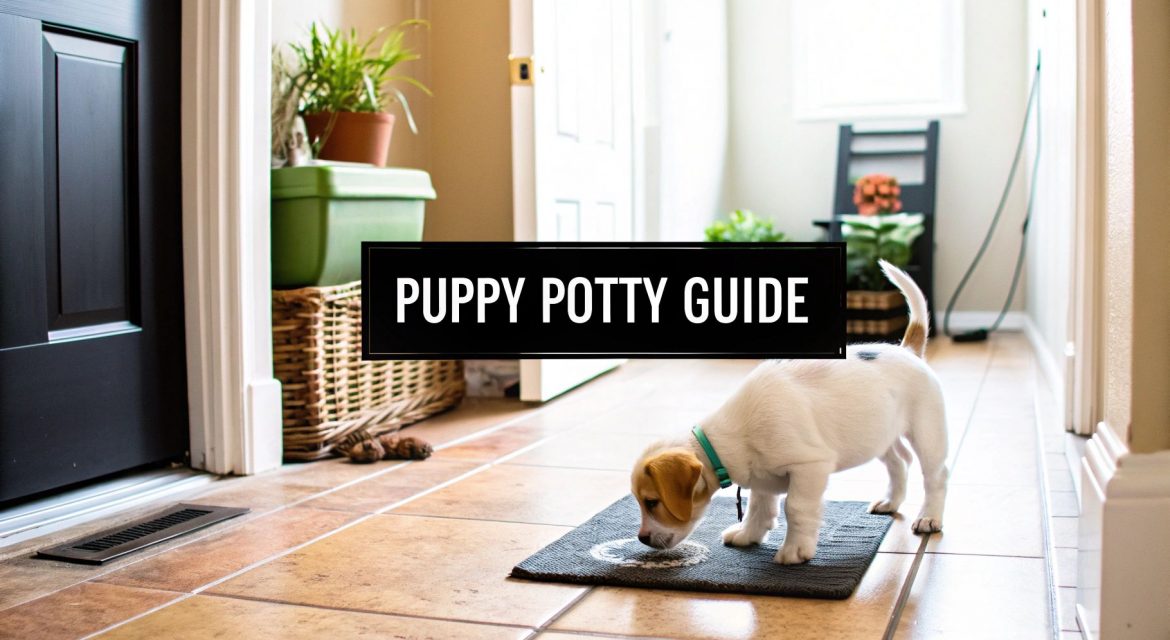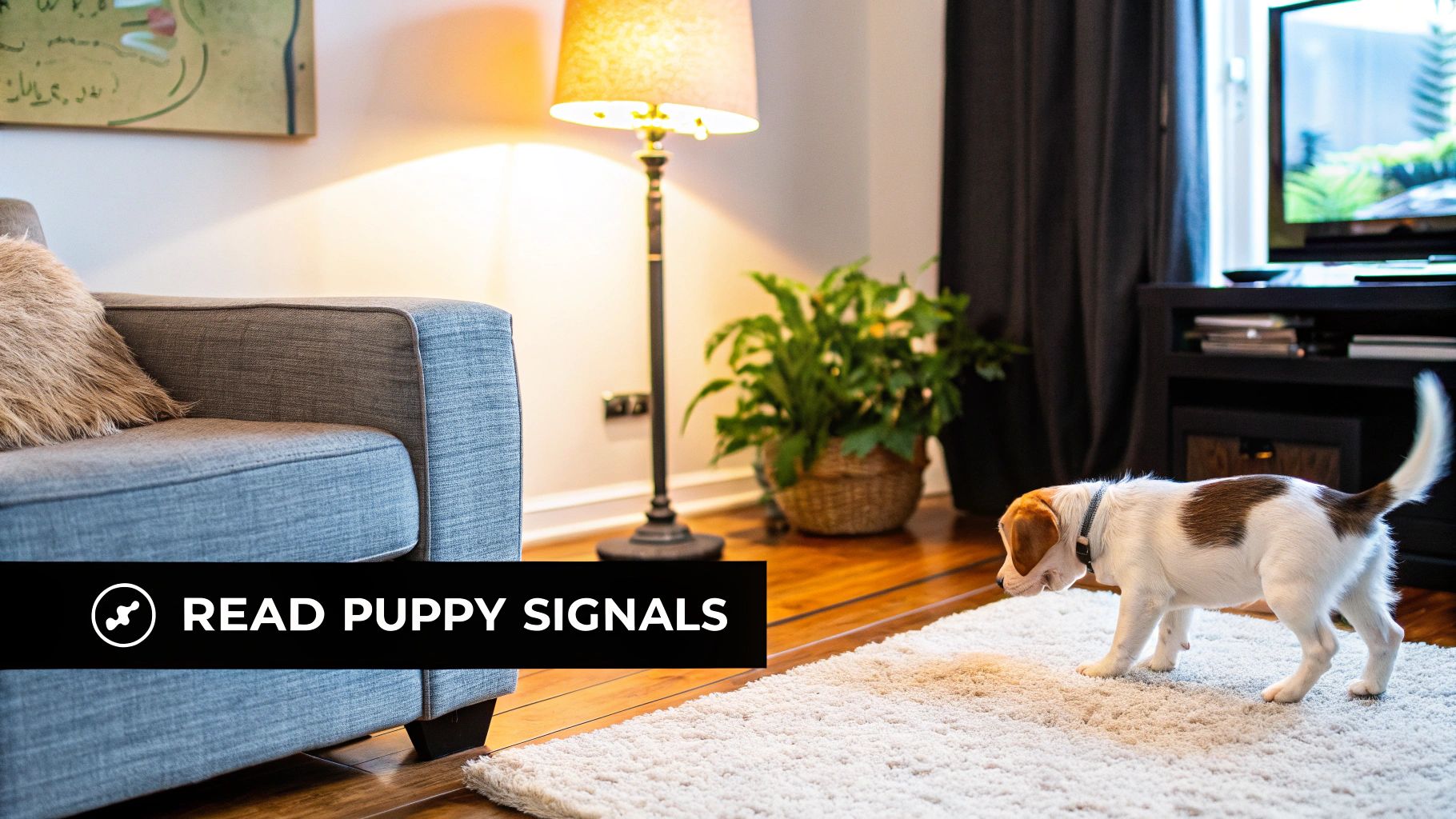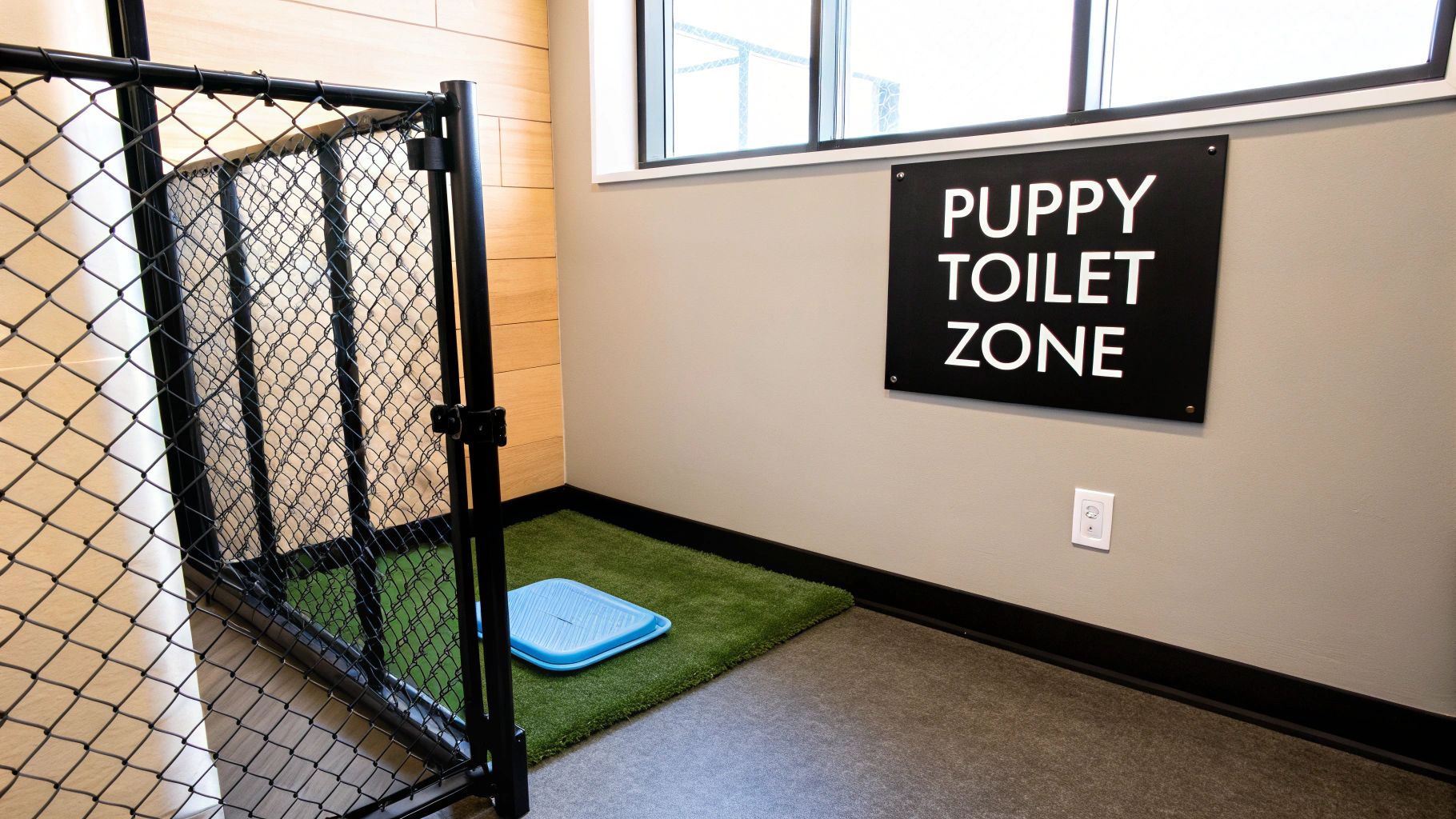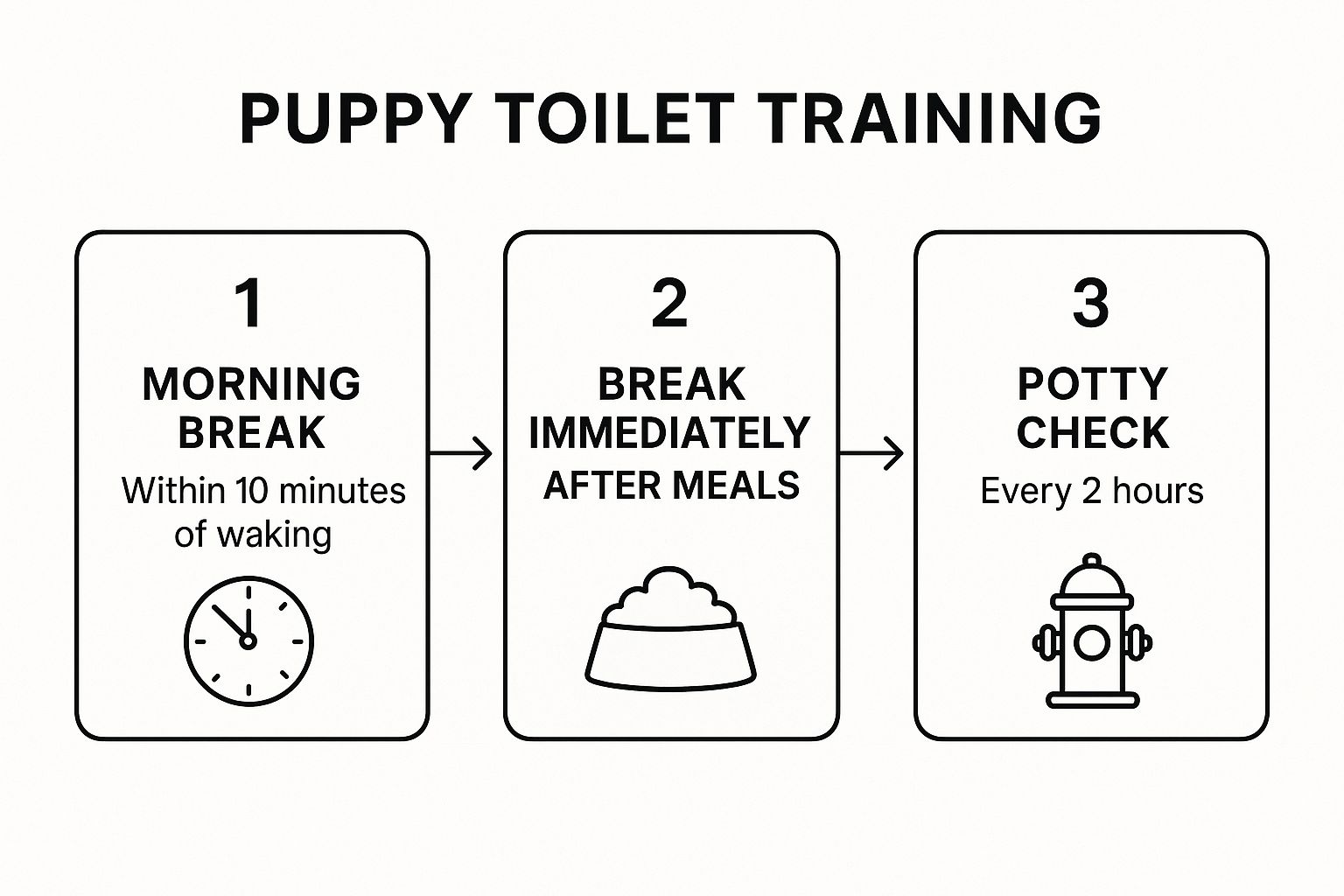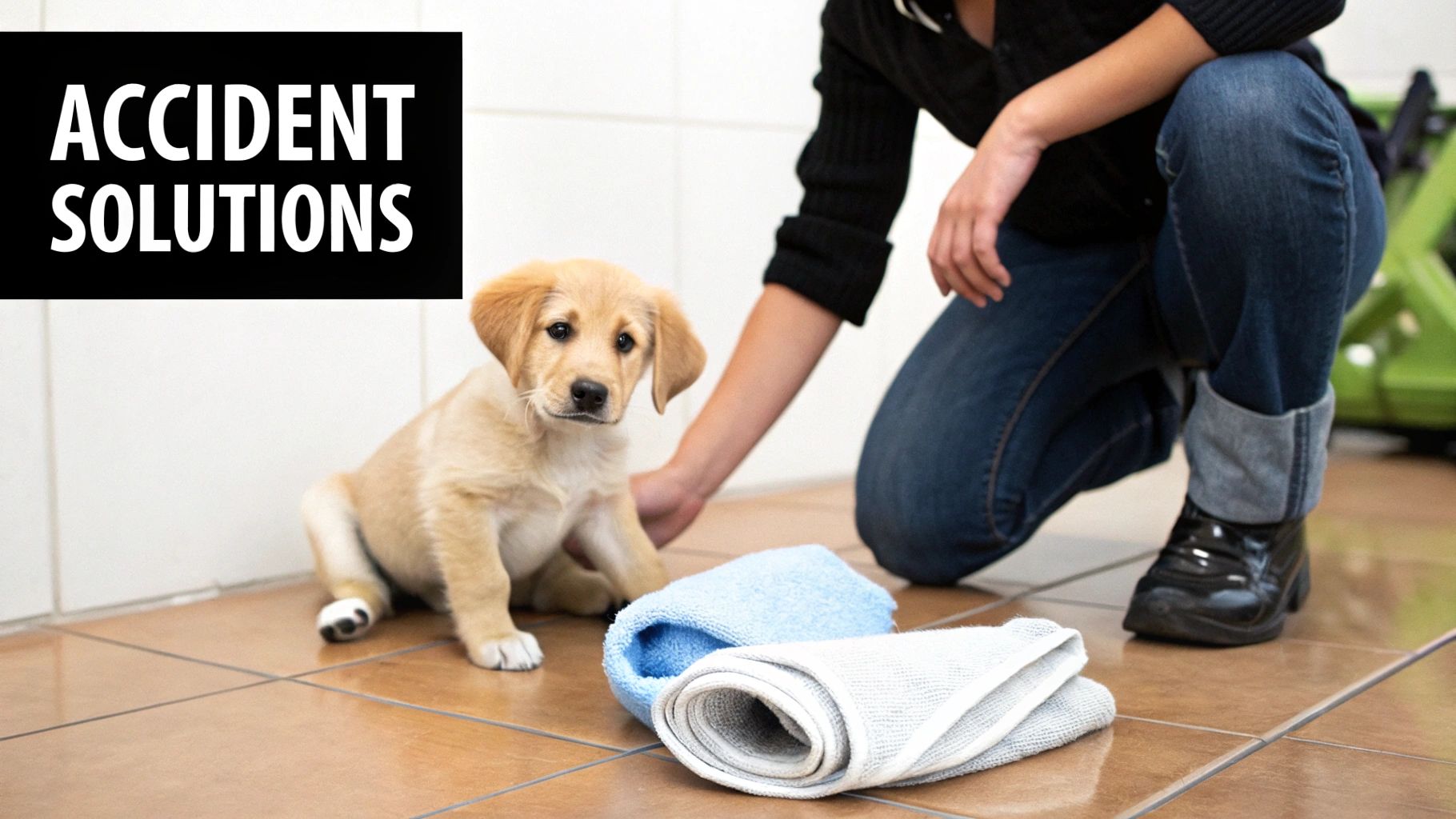To get toilet training right, you and I know it takes a solid plan built on three key things: consistency, patience, and positive reinforcement. It all boils down to creating a reliable routine for potty breaks and making a huge, happy fuss over your puppy the second they go in the right spot. This simple approach helps them figure out what we're asking, turning what feels like a massive task into a brilliant way for you to bond.
Welcome Home Your New Puppy
Bringing a new puppy home is just one of life’s purest joys, isn't it? That first wagging tail, the clumsy pounce, the sleepy cuddles… it’s a truly special time. But let’s be honest with each other—the first few puddles on the carpet can feel a bit overwhelming. If you’re feeling a mix of excitement and anxiety, please know you’re not alone. We've all been there.
This journey to a fully toilet-trained puppy is one we'll take together, focusing on understanding, not perfection. Instead of getting wound up by accidents, we’ll start by building a foundation of empathy for both you and your tiny companion.
Why Accidents Are Normal
Before we get into the "how-to," it’s really important for us to understand the "why." Your puppy isn't being naughty when they have an accident; they’re just being a puppy. Their little bodies and brains are still developing, which means they have next to no bladder control yet.
A young puppy, especially one under 12 weeks old, has a bladder about the size of a marble. They physically cannot "hold it" for long. Their muscles are still weak, and the connection between their brain signalling "I need to go!" and their body's ability to wait hasn't fully formed yet.
Remember, every accident is a learning opportunity, not a failure. It’s a sign that we, as owners, might have missed a cue or waited a bit too long between breaks.
Getting your head around this simple biological fact can completely shift your perspective. It moves you from a place of frustration to one of patience and proactive support. You become their guide, not their disciplinarian.
The Power of Positive Reinforcement
Throughout this guide, we're going to lean heavily on a kind and incredibly effective method called positive reinforcement. This is the cornerstone of modern, successful dog training, and it’s especially vital when you’re trying to toilet train a puppy.
So, what does this actually mean for us? It’s simple:
- We celebrate the wins: When your puppy goes to the toilet in the right place, we make a massive, happy fuss. Think enthusiastic praise, a delicious high-value treat, or a fun game of tug.
- We calmly manage the misses: When an accident happens indoors, we don't scold or punish. We just clean it up without any drama and make a mental note to take them out sooner next time.
This method does more than just teach your puppy where to wee and poo. It builds a powerful bond based on trust and clear communication. Your puppy learns that brilliant things happen when they get it right, which makes them eager to please you. They also learn that you are a safe, predictable person—and that’s crucial for their emotional well-being. Let's get you feeling confident and ready to guide your new family member with care.
Setting Up Your Home for Success
Before you even think about the training itself, a bit of prep work around the house will make your life a whole lot easier. Let's create an environment that sets both you and your puppy up for a win from day one. Getting this right makes the entire toilet training process feel smoother and far less stressful for both of you.
Think of it like puppy-proofing your home. You want everything in its right place to create a safe, structured space where your new friend can learn the ropes. This proactive approach helps prevent accidents before they happen and gives you the tools to handle them calmly when they inevitably do.
Creating Your Puppy’s Safe Haven
One of the most powerful tools in your toilet training kit is a crate. When you introduce it properly, a crate isn’t a cage; it’s your puppy's own personal den, a safe space they can retreat to. Dogs have a natural instinct to keep their sleeping area clean, and we can definitely use this to our advantage.
By making the crate a cosy and inviting spot, it becomes a place your puppy wants to be. This instinct means they will instinctively try not to soil their den, which is a massive help in teaching them to hold it for short periods. For a deeper dive into making the crate a happy place, check out our guide on how to crate train a puppy.
Your Essential Toilet Training Shopping List
Having the right supplies on hand makes a world of difference. You don't need to buy out the entire pet shop, but a few key items are completely non-negotiable for a smooth ride.
Here's a simple list to get you started:
- Enzymatic Cleaner: This is your absolute number one must-have. Standard household cleaners just won't cut it, as they can't break down the uric acid in urine. An enzymatic spray completely eliminates the odour molecules, which is crucial for stopping your puppy from being drawn back to the same spot for another accident.
- High-Value Treats: We’re not talking about their regular kibble here. You need small, extra-tasty treats (like tiny pieces of chicken, cheese, or hotdog) that are reserved only for successful toilet trips. This makes the reward feel really special and highly motivating.
- A Comfortable Crate: Choose one that’s large enough for your puppy to stand up and turn around in, but not so big they can use one end as a toilet and the other as a bed.
- Plenty of Paper Towels: Trust me, you’ll be grateful for having a good supply ready for those quick, no-fuss clean-ups.
Your goal is to be prepared. When an accident happens (and it will!), having your enzymatic cleaner and paper towels within arm's reach means you can deal with it calmly and efficiently without adding any stress to the situation.
Puppy Pads or Straight Outdoors?
This is a really common question, and honestly, the right answer depends entirely on your living situation. There’s no single "correct" choice, so let's weigh the pros and cons together to help you decide what's best for you and your new arrival.
Living in a high-rise flat or an area without a garden presents some unique challenges. It's no surprise that demand for pet training services is growing across the UK, especially in urban centres like London and Manchester where getting a puppy outside quickly just isn't always possible.
Here’s a simple breakdown to guide your decision:
| Method | Pros | Cons |
|---|---|---|
| Puppy Pads | – Convenient for flats or bad weather. – Good for very young pups with no bladder control. |
– Can teach your puppy that it's okay to go indoors. – Requires an extra step to transition them outside later. |
| Straight Outdoors | – Teaches the end goal from day one. – Avoids confusion about where the toilet is. |
– Requires frequent trips outside, regardless of weather. – Can be tough for those without a private garden. |
Ultimately, the best approach is the one you can stick to consistently. If you choose puppy pads, have a clear plan to gradually move the pad closer to the door and eventually outside. If you opt for going straight outdoors, just be prepared for lots and lots of trips, especially in those first few weeks. Either way, consistency is what will get you there.
Creating a Reliable Potty Routine
Consistency is your absolute best friend when toilet training a puppy. These little guys are creatures of habit, and they genuinely thrive on a predictable daily rhythm. Think of it less as a strict military schedule and more as a comforting, reliable pattern for their day—a pattern that you create and gently guide them through.
This isn't just about taking them out randomly and hoping for the best. It’s a strategic game of timing. By establishing a solid routine, you’re not just preventing accidents; you're actively teaching your pup the right time and the right place to do their business.
Timing Is Everything
A puppy's need to go to the toilet is surprisingly predictable because it’s directly linked to their daily activities. If you learn to anticipate these key moments, you can get ahead of the game and turn potential accidents into successful, praise-worthy potty breaks. You’re essentially teaching them, "This is when we go outside."
The most critical times for a potty break are:
- Immediately After Waking: First thing in the morning and right after every single nap. Their bladder will be full, making this the most likely time for success.
- Shortly After Meals: A full tummy puts pressure on everything else. Take them out around 15-20 minutes after they finish eating.
- Following Playtime: All that excitement and running around really gets their system going. A post-play potty break is non-negotiable.
- Just Before Bedtime: One final trip outside will help them stay comfortable through the night and seriously reduce the chances of a midnight mishap.
This simple flow shows the most essential parts of an effective routine.
As you can see, the routine is built around these predictable moments—waking, eating, playing, and sleeping—to maximise your chances of getting it right.
Learn Your Puppy's Unique Language
Beyond watching the clock, your puppy has their own way of telling you they need to go. Learning their specific "I need to pee!" signals is like cracking a secret code, and paying close attention to their body language is a massive part of being a proactive puppy parent.
Every dog is a little different, of course, but there are some classic signs to watch out for. You might notice them:
- Circling: Pacing in tight circles is a very common pre-potty ritual.
- Sniffing the ground intensely: They're searching for the perfect spot. If this happens indoors, it’s your cue to act fast!
- Whining or whimpering: A soft cry can be a sign of discomfort, often because their bladder is full.
- Suddenly stopping play: If they abruptly disengage from a fun game and start wandering off, they likely have something else on their mind.
When you see one of these signals, don't wait. Scoop them up calmly and take them straight to their designated toilet spot. This immediate action reinforces the connection between the urge to go and the correct location.
Recognising these subtle cues helps you intervene before an accident occurs, which is far more effective than reacting afterwards. Over time, you'll become an expert at reading your puppy's needs, strengthening your bond in the process. We've also put together an in-depth article where you can find out the best way to potty train a puppy.
Building a Sample Schedule
Okay, let's put it all together. Here’s a flexible timetable you can adapt to your own lifestyle. Just remember, this is a starting point—your puppy's age and individual needs will mean you have to make adjustments. For a very young puppy (8-10 weeks), you should be taking them out at least every hour they're awake.
Sample Daily Puppy Potty Schedule
Use this flexible timetable to establish a consistent routine for potty breaks, feeding, naps, and playtime. Adjust the times to fit your puppy and your lifestyle.
| Time of Day | Activity | Key Tip |
|---|---|---|
| 7:00 AM | First thing out of the crate, straight outside for a potty break. | Don't delay! Carry them if you must to avoid a puddle on the way to the door. |
| 7:15 AM | Breakfast time. | Remember to pick up their food bowl after about 15 minutes to establish a feeding routine. |
| 7:45 AM | Potty break after breakfast. | This is a key time to prevent post-meal accidents. |
| 8:00 AM – 9:00 AM | Supervised playtime and training session. | Keep a close eye on them during active periods. |
| 9:00 AM | Potty break after play. | All that fun gets their system moving. |
| 9:15 AM – 11:00 AM | Nap time in the crate. | This downtime helps prevent overstimulation and gives you a much-needed break. |
| 11:00 AM | Immediately outside after waking from their nap. | Their bladder will be full again. |
| Every 1-2 Hours | Continue taking them out consistently throughout the day, especially after any excitement. | Set a timer on your phone if it helps you remember! |
| 10:30 PM | Final potty break before bed. | Make it calm and boring—this isn't playtime. Praise them quietly when they're done. |
This structure might feel intense at first, but this level of consistency in the early weeks pays off massively. You are building a strong foundation of understanding that will last a lifetime. Every successful trip outside is another brick in that foundation, making the entire process to toilet train a puppy smoother for both of you.
Using Praise to Shape Good Habits
This is where the magic really happens. We’ve got the routine sorted and the house set up for success, but now we get to the heart of it all—building that brilliant, happy connection with your puppy. This isn't about managing messes anymore; it's about actively shaping your puppy’s behaviour in a way that feels like a fun game to them.
Think of this part of the journey as a conversation. You're about to teach your puppy exactly what you want them to do, using a language they understand perfectly: praise, tasty rewards, and your happy energy. It’s an incredibly powerful way to build their confidence and make your bond even stronger.
The Perfect Potty Praise
When your puppy gets it right, your reaction is everything. The goal is to make going to the toilet outside the most exciting, rewarding event of their day. It's this positive association that makes them want to do it again and again.
Here’s how we can create that "jackpot" moment:
- Pick a cue word: Choose a simple, consistent phrase you'll use every single time you take them to their spot. Something like "get busy" or "go potty." Say it in a calm, encouraging tone while they're sniffing around.
- Wait patiently: Give them a few minutes on a loose lead to do their business. Try not to talk to them or distract them during this time—let them focus.
- Reward instantly: The second they finish, it's party time! Shower them with enthusiastic praise like "Yes! Good puppy!" and immediately give them that special, high-value treat you've been saving just for this.
The timing here is absolutely critical. Rewarding them the moment they finish connects the action (weeing outside) with the reward (praise and a treat). If you wait until you're back inside, that connection is completely lost.
Your praise should be immediate and over-the-top. Think of yourself as their personal cheerleader. Your genuine excitement teaches them that going potty outside makes you incredibly happy, which is a massive motivator for any puppy.
What to Do When Accidents Happen
Now for the flip side. Knowing how to react when things don't go to plan is just as important as knowing what to do when they do. Punishing a puppy for an accident is one of the biggest mistakes we can make, and it can seriously set back your progress.
Scolding, shouting, or that old-fashioned (and awful) advice to rub their nose in it will only teach them one thing: that you are scary and unpredictable. It doesn't teach them where they should go; it just makes them afraid to go in front of you. This is what leads to puppies sneaking off to hide behind the sofa or under a bed to have an accident, making the problem so much harder for us to solve.
Instead, our approach is calm and completely fuss-free.
If you catch them in the act, make a quick noise like a single clap to interrupt them, then calmly scoop them up and take them straight outside. If they finish in the right spot, give them some gentle praise.
If you just find a puddle you missed, simply clean it up. There's zero value in telling them off after the fact—they won't connect your frustration with something they did minutes or even hours ago. Just grab your enzymatic cleaner and move on. Building on this foundation is key to mastering positive reinforcement dog training techniques.
Why This Method Works
At its core, this approach is about building trust, not fear. Every positive interaction reinforces your bond and helps your puppy see training as a delightful collaboration rather than a stressful test they might fail.
This focus on positive methods is becoming the norm, especially among younger pet owners in the UK. Millennial and Gen Z owners are a real driving force in the pet training industry. In fact, research shows that 41% of Gen Z dog owners pay for professional training, prioritising house training to fit their lifestyles. You can explore more about these dog trends for 2025. By using praise, you’re not just training; you’re nurturing a happy, confident companion who is genuinely eager to please you.
Troubleshooting Common Potty Problems
First things first, let's take a deep breath together. Accidents are going to happen. It’s a completely, one hundred percent normal part of the process. A puddle on the floor isn't a sign of failure from you or your puppy. Think of it as a bump in the road, not a total derailment.
Let's look at some of the common hurdles you might face. When you start seeing these moments as puzzles to solve rather than problems to punish, it completely transforms your mindset. This is all about building your confidence as a pet parent, so you can handle any setback with patience and get right back on track.
The Mystery of Potty Training Regression
Have you been celebrating a week of accident-free success, only to find your puppy has suddenly forgotten everything they’ve learned? It’s a hugely frustrating experience known as potty training regression, and it's incredibly common. We've all felt that dip in our stomachs when it happens.
This kind of setback often pops up around 4-6 months of age as your puppy hits their teenage phase. They might be testing boundaries or simply got distracted and forgot the rules. It can also be triggered by a change in their routine, like moving house or a new family schedule.
The key is not to panic. The best response is to go right back to basics for a week or two.
- More frequent potty breaks: Yep, it’s back to taking them out every hour, just like you did at the very beginning.
- Re-establish supervision: Don't give them unsupervised freedom to roam the house. Bring back the crate and baby gates to manage their space.
- Make the rewards amazing again: Go back to using those super high-value treats and celebrate every single outdoor success with massive enthusiasm.
Potty training regression feels like a huge step backwards, but it's almost always temporary. By reinforcing the foundational rules with patience, you’re simply reminding your puppy of the routine they already know.
Understanding Submissive or Excitement Urination
Does your puppy leave a little puddle when they greet you at the door or when a visitor says hello? This is likely submissive or excitement urination, and it’s an involuntary behaviour, not a deliberate accident.
Your puppy isn't being naughty; they're either overwhelmed with joy or trying to show they aren't a threat. Punishing them for this will only make the problem worse because it ramps up their anxiety.
Instead, we need to change the situation itself:
- Keep greetings calm and low-key: When you come home, try to ignore your puppy for the first minute. Avoid direct eye contact and crouch down to their level instead of towering over them.
- Ask visitors to do the same: Instruct guests to be very calm when they arrive. A great trick is to have them toss a treat on the floor away from the puppy to redirect their focus.
- Build their confidence: Engage in fun training games and activities that empower your puppy and make them feel more self-assured.
This isn't a house-training issue in the traditional sense; it’s an emotional response. As your puppy matures and gains confidence, this behaviour nearly always fades away on its own.
The Classic "Plays Outside But Pees Inside" Problem
This is one of the most baffling scenarios for any new puppy owner. You spend ages outside, your puppy has a wonderful time chasing leaves and sniffing everything, but the second you get back inside… there’s a puddle.
So, what’s going on here? Usually, it means the garden has become a place for play, not for business. Your puppy is simply too distracted by all the exciting sights and smells to focus on the task at hand.
To solve this, we need to create a clear distinction between potty time and playtime.
- Start with "boring" potty trips: Take your puppy out on a lead to their designated spot. Stand still and be as uninteresting as you possibly can.
- Use your cue word: Calmly repeat your cue word, like "get busy." Give them about five minutes.
- Reward and then play: The moment they go, shower them with huge praise and their special treat. Then, as a bonus reward, you can unclip the lead for a fun game of fetch.
By structuring your garden trips this way, you teach them that doing their business first is what unlocks all the fun.
The UK has seen a huge rise in pet ownership, with over 3 million households getting a pet since the pandemic began. This shift has brought new challenges, as 17% of families found training harder than expected, underscoring why understanding these common issues is so vital for keeping pets in their forever homes. You can discover more insights about these pet population trends from the Pet Food Manufacturers' Association.
Your Puppy Toilet Training Questions Answered
We’ve covered a lot of ground together, but I bet you still have a few specific questions buzzing around. That’s completely normal! Every puppy parent wonders if they’re getting it right.
So, let's dive into some of the most common questions we hear from new owners who are right in the thick of toilet training. Think of this as a quick-fire round to give you that extra bit of confidence.
How Long Does It Really Take to Toilet Train a Puppy?
This is the big one, isn't it? The million-dollar question. The honest answer is that every single puppy learns at their own pace.
While most pups are reliably house-trained within 4 to 6 months, it’s not a race. Some smaller breeds, for instance, have even smaller bladders and might naturally take a bit longer.
Think of it as progress, not a deadline. Your puppy's breed, their age when you started, and your own consistency all play a massive role. It's not unheard of for some puppies to take up to a year to be completely accident-free, and that is absolutely okay.
Are Puppy Pads a Good or Bad Idea?
Puppy pads can feel like a real lifesaver, especially if you live in a flat without a garden or you're facing a week of dreadful British weather. They definitely have their place and can be a useful tool in the early days.
However, there is a catch. Using pads can accidentally teach your puppy that weeing indoors is an acceptable option, which can create a bit of confusion down the line when you want them to go exclusively outside.
If you decide to use puppy pads, the key is to have a clear exit strategy from the start. Your goal should always be to transition them outside. You can do this by slowly moving the pad closer and closer to the door, and then eventually placing it right outside where you want them to go.
This phased approach helps bridge the gap between indoor and outdoor toileting, making the final switch much smoother for your little one.
What Should I Do If I Catch My Puppy Having an Accident?
It’s so easy to feel a surge of frustration in this moment, but how you react right here is crucial. The absolute golden rule is to avoid scolding or punishing them. Your goal is simply to interrupt the behaviour, not to scare your puppy.
A quick, surprising noise—like a single, sharp clap—is usually enough to get their attention and make them pause. The second they stop, calmly and quickly guide them to their designated toilet spot outside.
If they happen to finish their business in the right place, praise them with the same enthusiasm you would for any other success. This turns a potential negative into a positive learning moment.
And what if you find the mess later? Just clean it up. There is absolutely no point in telling them off after the fact; they won't connect your anger to the puddle they made an hour ago. It only creates anxiety and can make them fearful of you, which is the last thing we want. A thorough clean with a good enzymatic spray is all that's needed.
At My Life My Dog, we're here to support you through every step of your journey, from the first wobbly steps to a lifetime of happy companionship. For more expert guides and tips, visit us at https://mylifemydog.com.


